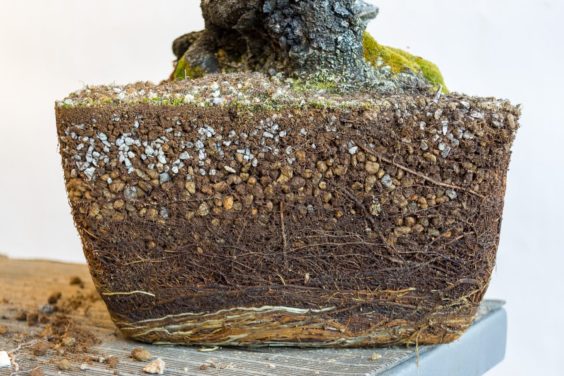For as important as roots are to healthy bonsai, we don’t often get a good look at how they grow in the pot. Few containers offer a view at what’s going on inside and we often disturb the roots with sickles or chop sticks when removing trees from their containers.
I got a particularly good view of the roots on a plum bonsai this year. I’ve been caring for and repotting the tree for the past 25 years so I’m familiar with how the roots grow, what size pot the tree likes and which soils work best for the tree.
Roots on a plum bonsai
Due to the speed with which the roots grow, I repot the tree every year. The soil mix is 50-60% akadama with the remainder consisting of pumice (the white particles) or kiryu (the yellow particles). The bottom half inch is straight pumice.
As is clear in the photo, there are more roots in the bottom half of the rootball than in the top half, and far more roots in the bottom inch than anywhere else – the course roots obscuring any view of the pumice layer.
Getting such a clear view of the roots made me wonder if there is any benefit to changing the distribution of roots in the pot – or if it’s even possible. The roots have looked like this every time I’ve repotted the tree, despite the different mixes I’ve used over the years. Clearly, the tree likes the available air and water near the bottom of the pot. Or is it the temperature? Or are plum roots programmed to grow as much and as low as possible?
It wouldn’t be tricky to answer these questions if I had enough similar trees to test different hypotheses. Just for fun, I rooted a number of cuttings from this tree a few years ago so I may get the chance to run some tests. That said, the tree typically produces the slow growth that I look for at this stage of development so there may be more pressing questions to investigate.
In the meantime, I’ll keep making small tweaks to the soil – different sizes, particle types, etc. – and see if any patterns emerge.
Subscribe to Indian Bonsai Art
New Posts Delivered Every Tuesday and Friday

